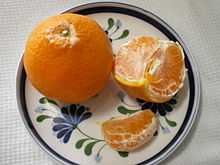Kiyomi
| Kiyomi | |
|---|---|
 | |
| Kiyomi | |
| Scientific classification | |
| Kingdom: | Plantae |
| (unranked): | Angiosperms |
| (unranked): | Eudicots |
| (unranked): | Rosids |
| Order: | Sapindales |
| Family: | Rutaceae |
| Genus: | Citrus |
| Species: | C. unshiu × sinensis |
| Binomial name | |
| Citrus unshiu × sinensis | |
Kiyomi (清見 kiyomi) is a Japanese citrus fruit that is a hybrid (Citrus unshiu × Citrus sinensis) of a Miyagawa Wase mikan and a Citrus sinensis[1] orange. The new breed was the first tangor created in Japan in 1949. It was named Kiyomi after the temple Seiken-ji (清見寺) and the lagoon Kiyomi-gata (清見潟) near its experiment station in Shizuoka city and registered as "Tangor Nōrin No.1"[2] in 1979.[3]
Kiyomi are sweet. Sugar content is normally 11–12°Bx and reaches even 13°Bx if conditions met. Citric acid content is around 1%. It has no seeds. The time of ripening is mid to late March.[3] The flavor is similar to that of a mikan, while the aroma is similar to that of an orange.[citation needed]
Kiyomi is monogerm, so that it is often used as a parent citrus to create new hybrids such as Dekopon.
References
- ↑ "Trovita sweet orange". University of California Riverside.
- ↑ Tangor agricultural and forestry No.1 (タンゴール農林1号)
- ↑ 3.0 3.1 Nishiura, Masao et al. (1983). "Kiyomi: A new variety of citrus". Bulletin of Fruit Tree Research Station B (in Japanese) (Ministry of Agriculture and Forestry Japan) (10:1-9).
External links
- Kiyomi at the National Agriculture and Food Research Organization (in Japanese)